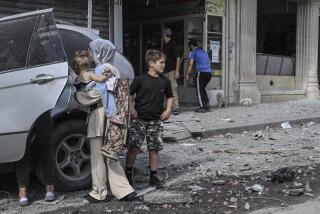PERSPECTIVE ON DEFENSE POLICY : Non-Lethal Weapons for a Postmodern World : High-tech applications of lasers, for example, can immobilize a foe--useful from Bosnia to Somalia to our own city streets.
- Share via
Question: What do Somalia, Bosnia and Waco have in common?
Answer: “Peacekeepers” killing people.
The most recent toll involved Pakistani and American forces under U.N. auspices killing Somali civilians, prompting a mob of angry Somalis to turn on journalists, killing at least two. It need not have been that way if the U.N. forces had been armed with non-lethal weapons. Will American forces deployed in Montenegro or elsewhere under U.N. auspices face similar situations? Probably, and they will be armed with weapons designed to kill, not temporarily incapacitate.
Non-lethality is a defense policy concept that hinges on fielding weapons to contain barbarism, halt aggression and stop violence, but not kill people. Non-lethal weapons can be gases that do not kill or maim, only temporarily demobilize or put to sleep; low- or high-frequency sound waves, operating on principles similar to invisible fencing for pets, or laser-like devices that cause temporary blindness.
Non-lethality means managing conflicts with incapacitating forces. The United States has the technological resources to begin fielding non-lethal weapons and to develop relevant strategies and tactics. Many senior military strategists in and out of government are examining this approach. More should be. During the three years since the first non-lethality briefings were given in the Pentagon, the world situation has provided numerous cases where non-lethal weapons, or even the threat of using them, could have saved countless lives and incalculable damage to our psychic and physical environment.
So why don’t we have non-lethal weapons? Why didn’t the last Administration, or the current one, proclaim a national non-lethal policy?
Non-lethal weapons are relatively cheap, so it’s not a question of money. Maybe it’s a question of leadership or parochial interests. Maybe experts are spending too much time defending old programs and not enough thinking about new, post-Cold War options. Or maybe it’s a question of established interests preventing change if it threatens established funding streams.
The world is fundamentally in need of forces that can separate combatants, stop genocide, restore order and disarm aggressors without becoming parties to a widening conflict. Think of what it would mean to the future of the destabilized world if the muddled politics of Bosnian, Serbian and Croatian ethnic feuds were immaterial to a solution of the bloodshed there. Think of what it would mean if the world community could field forces to separate and disarm such warring factions instead of killing them. Think of what it would mean if U.N. peacekeepers had options beyond rubber bullets or tear gas; options that could short-circuit violent outbreaks without risk that the user will become party to a widening war; options that are life-conserving, fiscally responsible and environmentally friendly.
Tinpot dictators and Saddam wannabes would think twice before risking the intercession of a United States that wasn’t afraid of looking like a Goliath against the David they so inevitably play for eager CNN cameramen. Hostage situations and brute force could equally be met with overwhelming--but non-lethal--responses in which perpetrators risked international censure, forced disarmament and disgrace, but never became dignified or legitimized on the great stage of international conflict.
Or, perhaps you don’t give a hoot about U.S. leadership abroad. Perhaps you’re one of those who are tempted by the New Isolationism. Then, if you prefer, think of what it could have meant in Los Angeles last year if local and state authorities could have defused the violence there without risking lives--and stopped the rampage that cost so much in damage to property, businesses, careers and the sense of community that defines American pluralism.
Or, think of a future without non-lethal weapons. Think of what it says about our ability to control domestic violence, terrorism or crime when, in Waco, the federal government resorted to technology dating back to 1928 and the result was a inferno of retribution. Since the 1960s, three such domestic incidents have occurred: the 1974 Symbionese Liberation Army occupation and siege in Los Angeles, the 1985 MOVE incident in Philadelphia and the debacle in Waco. In each case, tear gas and lethal force have been our response. In each case, we’ve burned the buildings to the ground, immolating nearly everyone inside.
Everyone agrees there must be a better way to deal with such crises. The proponents of non-lethality have one. It will mean conserving, rather than cannibalizing, our defense base. It will mean converting a fraction of our massive military capability to non-lethal peace-making and police use. It will mean retooling some of our increasingly idle defense plants. It will mean creating new jobs for highly skilled defense workers. It might even mean the beginning of a new arms race--a race toward the least-lethal weapon.
Admittedly, there is some risk of such a new arms race if the United States, still the international pacesetter, announces a non-lethality policy. But, given the alternatives--a hollow force, increased isolationism, impotent Cold War strategies, outmoded peacekeeping tactics, larger transnational crime cartels, an increasingly destabilized multipolar world, the risk of domestic violence, inadequate police technology--non-lethality is the only viable option for a future in which the United States intends to play a leadership role--or even have a significant part.
More to Read
Sign up for Essential California
The most important California stories and recommendations in your inbox every morning.
You may occasionally receive promotional content from the Los Angeles Times.










